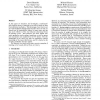Free Online Productivity Tools
i2Speak
i2Symbol
i2OCR
iTex2Img
iWeb2Print
iWeb2Shot
i2Type
iPdf2Split
iPdf2Merge
i2Bopomofo
i2Arabic
i2Style
i2Image
i2PDF
iLatex2Rtf
Sci2ools
COLT
1994
Springer
1994
Springer
Rigorous Learning Curve Bounds from Statistical Mechanics
In this paper we introduce and investigate a mathematically rigorous theory of learning curves that is based on ideas from statistical mechanics. The advantage of our theory over the well-established Vapnik-Chervonenkis theory is that our bounds can be considerably tighter in many cases, and are also more re ective of the true behavior (functional form) of learning curves. This behavior can often exhibit dramatic properties such as phase transitions, as well as power law asymptotics not explained by the VC theory. The disadvantages of our theory are that its application requires knowledge of the input distribution, and it is limited so far to nite cardinality function classes. We illustrate our results with many concrete examples of learning curve bounds derived from our theory.
COLT 1994 | Learning Curve | Machine Learning | Theory | Well-established Vapnik-chervonenkis Theory |
| Added | 09 Aug 2010 |
| Updated | 09 Aug 2010 |
| Type | Conference |
| Year | 1994 |
| Where | COLT |
| Authors | David Haussler, H. Sebastian Seung, Michael J. Kearns, Naftali Tishby |
Comments (0)

